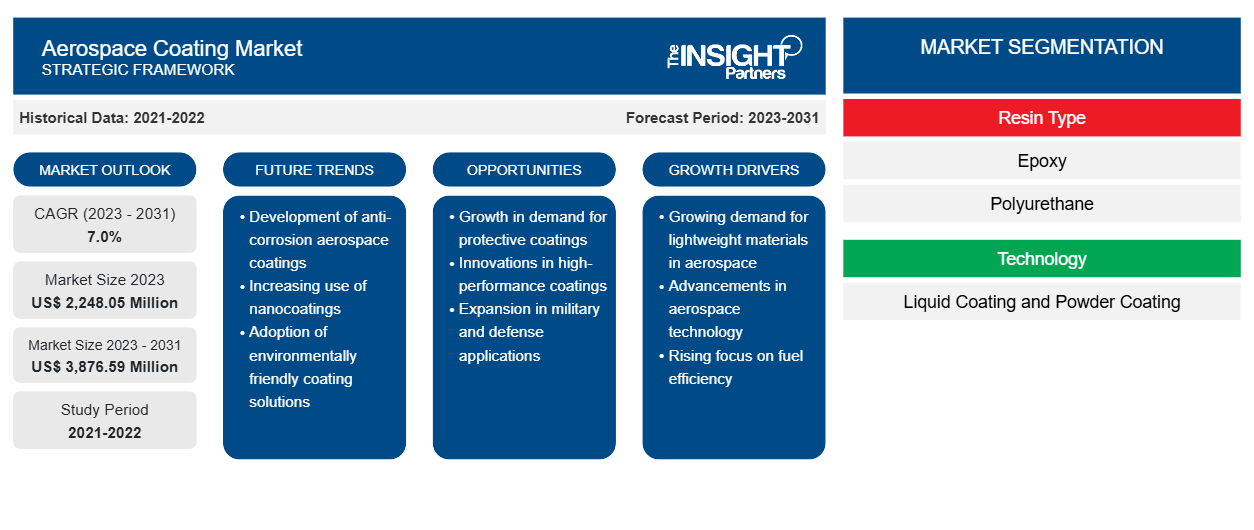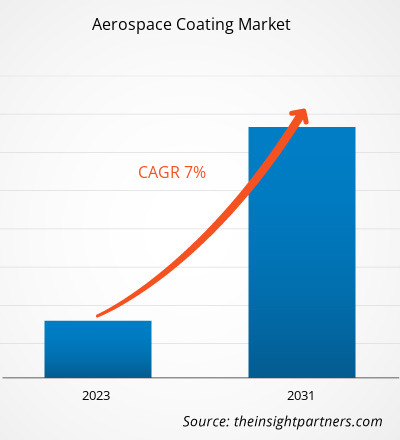Aerospace Coating Market Size and Competitive Analysis by 2031
Historic Data: 2021-2022 | Base Year: 2023 | Forecast Period: 2023-2031Aerospace Coating Market Size and Forecast (2020–2031), Global and Regional Share, Trend, and Growth Opportunity Analysis Report Coverage: By Resin Type (Epoxy, Polyurethane, and Others), Technology (Liquid Coating and Powder Coating), End User (Commercial Aviation, Military Aviation, and General Aviation), and Geography
- Report Date : Mar 2026
- Report Code : TIPTE100001324
- Category : Chemicals and Materials
- Status : Data Released
- Available Report Formats :


- No. of Pages : 150
The aerospace coating market size is projected to reach US$ 3,876.59 million by 2031 from US$ 2,248.05 million in 2023. The market is expected to register a CAGR of 7.0% during 2023–2031. Increasing demand for commercial aircraft and innovation in the aerospace coating industry are likely to remain key trends in the aerospace coating market.
Aerospace Coating Market Analysis
The demand for aerospace coating materials is increasing notably across North American countries. The region is on the path of becoming one of the largest markets for aerospace coatings. The surging demand for aerospace coating products in the region is ascribed to the booming aerospace industry in the US, in addition to the emergence of major aerospace players in North American countries. Companies such as Airbus, Lockheed Martin, and Boeing are major players in the aerospace coating market across the world. Further, the governments of key countries in North America have been increasing their spending on the procurement and maintenance of military aircraft, which is likely to trigger the demand for coating products for military aerospace applications. The flourishing commercial aviation industry in countries such as Canada and the US is also expected to propel the demand for aerospace coatings in these countries.
Aerospace Coating Market Overview
Aircraft has to withstand high climatic stress that may result in frequent repair and maintenance needs due to damaged metal surfaces. Aerospace coatings provide resistance against corrosion, ultraviolet rays, solar heat, and fog and other adverse weather conditions. In addition to providing protection to the aircraft, these coatings also help reduce the wright of the aircraft, in turn, bringing down carbon dioxide emissions. Modifications or amendments in environmental regulations also impact the demand for aircraft coatings. Aerospace coatings are designed to safeguard aircraft from the effects of temperature fluctuations, air pressure variations, and air instabilities. Further, miniaturization, precision, and high strength have become the important features of aerospace coatings.
Customize This Report To Suit Your Requirement
You will get customization on any report - free of charge - including parts of this report, or country-level analysis, Excel Data pack, as well as avail great offers and discounts for start-ups & universities
Aerospace Coating Market: Strategic Insights

-
Get Top Key Market Trends of this report.This FREE sample will include data analysis, ranging from market trends to estimates and forecasts.
Aerospace Coating Market Drivers and Opportunities
Various Benefits Provided by Aerospace Coating to Favor Market
Aerospace coatings are considered as a high-performance coating material that helps in protecting the aircraft from harsh weather conditions that can cause damage to the aircraft resulting in maintenance and repairs. There has been a strong demand for aerospace coating products from the maintenance, repair, and overhaul (MRO) industry in the regions having long haul routes. New technologies, such as chrome-based coatings, protect the aircraft from UV exposure at higher altitudes. The new coating technologies have advanced capabilities that will help the aviation industry in cost-saving. Thus, various benefits provided by aerospace coating are expected to drive the market growth.
Growing Demand for Commercial Aircraft
Affordable commercial air travel has emerged as one of the feasible options in developing countries, which provides travelers with a variety of destinations. Consumers in developing economies prefer air travel as it provides speed and time convenience, which the traditional modes of transportation do not provide. The rising demand for commercial air travel has increased due to the increase in tourism and decrease in travel cost, which leads to an increase in the number of commercial aircraft across the world, which, in turn, will provide an opportunity for the aerospace coatings market. The increase in passenger travel, coupled with the economic growth of developing companies, is going to enhance commercial aircraft production across the world.
Aerospace Coating Market Report Segmentation Analysis
Key segments that contributed to the derivation of the aerospace coating market analysis are resin type, technology, and end user.
- Based on resin type, the aerospace coating market is segmented into epoxy, polyurethane, and others. The polyurethane segment held the largest market share in 2023.
- By technology, the market is divided into liquid coatings and powder coatings. The liquid coating segment held a larger share of the market in 2023.
- In terms of end user, the market is segmented into commercial aviation, military aviation, and general aviation. The commercial aviation segment dominated the market in 2023.
Aerospace Coating Market Share Analysis by Geography
The geographic scope of the aerospace coating market report is mainly divided into five regions: North America, Asia Pacific, Europe, Middle East & Africa, and South America/South & Central America.
North America has dominated the aerospace coating market. The presence of key aerospace coating manufacturers, well-established commercial and military aviation, and growing number of commercial and international flights are among the factors contributing to the growth of the aerospace coatings market in Asia Pacific. Asia Pacific is anticipated to grow with the highest CAGR in the coming years.
Aerospace Coating Market Regional Insights
The regional trends and factors influencing the Aerospace Coating Market throughout the forecast period have been thoroughly explained by the analysts at The Insight Partners. This section also discusses Aerospace Coating Market segments and geography across North America, Europe, Asia Pacific, Middle East and Africa, and South and Central America.
Aerospace Coating Market Report Scope
| Report Attribute | Details |
|---|---|
| Market size in 2023 | US$ 2,248.05 Million |
| Market Size by 2031 | US$ 3,876.59 Million |
| Global CAGR (2023 - 2031) | 7.0% |
| Historical Data | 2021-2022 |
| Forecast period | 2023-2031 |
| Segments Covered |
By Resin Type
|
| Regions and Countries Covered |
North America
|
| Market leaders and key company profiles |
|
Aerospace Coating Market Players Density: Understanding Its Impact on Business Dynamics
The Aerospace Coating Market is growing rapidly, driven by increasing end-user demand due to factors such as evolving consumer preferences, technological advancements, and greater awareness of the product's benefits. As demand rises, businesses are expanding their offerings, innovating to meet consumer needs, and capitalizing on emerging trends, which further fuels market growth.

- Get the Aerospace Coating Market top key players overview
Aerospace Coating Market News and Recent Developments
The aerospace coating market is evaluated by gathering qualitative and quantitative data post primary and secondary research, which includes important corporate publications, association data, and databases. The following is a list of developments in the market for speech and language disorders:
AkzoNobel Aerospace Coatings will launch Aerofleet Coatings Management, a new digital, data-driven service that helps airlines and other large operators to tailor and optimize the coatings’ replacement and maintenance schedule for individual aircraft within an airline fleet. (Source: AkzoNobel N.V., Press Release, 2023)
Aerospace Coating Market Report Coverage and Deliverables
The “Aerospace Coating Market Size and Forecast (2021–2031)” report provides a detailed analysis of the market covering below areas:
- Market size and forecast at global, regional, and country levels for all the key market segments covered under the scope
- Market dynamics such as drivers, restraints, and key opportunities
- Key future trends
- Detailed PEST/Porter’s Five Forces and SWOT analysis
- Global and regional market analysis covering key market trends, major players, regulations, and recent market developments
- Industry landscape and competition analysis covering market concentration, heat map analysis, prominent players, and recent developments
- Detailed company profiles
Habi is a seasoned Market Research Analyst with 8 years of experience specializing in the Chemicals and Materials sector, with additional expertise in the Food & Beverages and Consumer Goods industries. He is a Chemical Engineer from Vishwakarma Institute of Technology (VIT) and has developed deep domain knowledge across industrial and specialty chemicals, paints and coatings, paper and packaging, lubricants, and consumer products. Habi’s core competencies include market sizing and forecasting, competitive benchmarking, trend analysis, client engagement, report writing, and team coordination—making him adept at delivering actionable insights and supporting strategic decision-making.
- Historical Analysis (2 Years), Base Year, Forecast (7 Years) with CAGR
- PEST and SWOT Analysis
- Market Size Value / Volume - Global, Regional, Country
- Industry and Competitive Landscape
- Excel Dataset
Related Reports
Testimonials
The Insight Partners' SCADA System Market report is comprehensive, with valuable insights on current trends and future forecasts. The team was highly professional, responsive, and supportive throughout. We are very satisfied and highly recommend their services.
RAN KEDEM Partner, Reali Technologies LTDsI requested a report on a very specific software market and the team produced the report in a few days. The information was very relevant and well presented. I then requested some changes and additions to the report. The team was again very responsive and I got the final report in less than a week.
JEAN-HERVE JENN Chairman, Future AnalyticaWe worked with The Insight Partners for an important market study and forecast. They gave us clear insights into opportunities and risks, which helped shape our plans. Their research was easy to use and based on solid data. It helped us make smart, confident decisions. We highly recommend them.
PIYUSH NAGPAL Sr. Vice President, High Beam GlobalThe Insight Partners delivered insightful, well-structured market research with strong domain expertise. Their team was professional and responsive throughout. The user-friendly website made accessing industry reports seamless. We highly recommend them for reliable, high-quality research services
YUKIHIKO ADACHI CEO, Deep Blue, LLC.This is the first time I have purchased a market report from The Insight Partners.While I was unsure at first, I visited their web site and felt more comfortable to take the risk and purchase a market report.I am completely satisfied with the quality of the report and customer service. I had several questions and comments with the initial report, but after a couple of dialogs over email with their analyst I believe I have a report that I can use as input to our strategic planning process.Thank you so much for taking the extra time and making this a positive experience.I will definitely recommend your service to others and you will be my first call when we need further market data.
JOHN SUZUKI President and Chief Executive Officer, Board Director, BK TechnologiesI wish to appreciate your support and the professionalism you displayed in the course of attending to my request for information regarding to infectious disease IVD market in Nigeria. I appreciate your patience, your guidance, and the fact that you were willing to offer a discount, which eventually made it possible for us to close a deal. I look forward to engaging The Insight Partners in the future, all thanks to the impression you have created in me as a result of this first encounter.
DR CHIJIOKE ONYIA MANAGING DIRECTOR, PineCrest Healthcare Ltd.Reason to Buy
- Informed Decision-Making
- Understanding Market Dynamics
- Competitive Analysis
- Identifying Emerging Markets
- Customer Insights
- Market Forecasts
- Risk Mitigation
- Boosting Operational Efficiency
- Strategic Planning
- Investment Justification
- Tracking Industry Innovations
- Aligning with Regulatory Trends




















 Get Free Sample For
Get Free Sample For